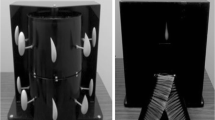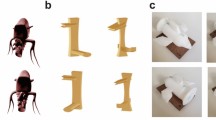Abstract
Scene recognition has been found to be sensitive to the orientation of the scene with respect to the stationary observer. Recent studies have shown, however, that observer movement can compensate for changes in visual scene orientation, through a process of spatial updating. Here we investigated whether spatial updating in scene recognition is affected by the encoding or learning modality by examining whether observer movement can also compensate for orientation changes in haptic scene recognition. In experiment 1, we replicated previously reported effects of observer movement on visual scene recognition. In experiment 2, we used the same apparatus as in experiment 1 but here participants were required to learn and recognize the scenes using touch alone. We found a cost in recognition performance with changes in scene orientation relative to the stationary observer. However, when participants could move around the scene to recognize the new orientation, then this cost in recognition performance disappeared. Thus, we found that spatial updating applies to recognition in both the visual and haptic modalities, both of which intrinsically encode the spatial properties of a scene.



Similar content being viewed by others
Notes
All the studies reported here were approved by the Trinity College Department of Psychology Ethics Committee.
Although this ISI is longer than in previous studies (e.g. 7 s in Wang and Simon’s 1999 study) this duration was necessary for practical reasons but mainly to allow for the same ISI across experiments 1 and 2. We found no evidence that this increase in ISI between learning and testing affected the spatial updating (see, Hollins and Kelley 1988) although that is not to say that any further increase might indeed disrupt updating.
Although the terms “viewing” and “viewpoint” are more synonymous with visual processing, we prefer to use the same terms of reference across experiments to minimize confusion.
This experiment was based on a between-subjects design, thus our post hoc analysis was conducted using Tukey HSD analysis rather than a Newman–Keuls as in experiment 1.
References
Avraamides MN (2003) Spatial updating of environments described in texts. Cognit Psychol 47:402–431
Christou CG, Bülthoff HH (1999) View dependence in scene recognition after active learning. Mem Cognit 27:996–1007
Christou CG, Tjan BS, Bülthoff HH (2003) Extrinsic cues aid shape recognition from novel viewpoints. J Vis 3:183–198
Diwadkar VA, McNamara TP (1997) Viewpoint dependence in scene recognition. Psychol Sci 8:302–307
Easton RD, Sholl MJ (1995) Object-array structure, frames of reference, and retrieval of spatial knowledge. J Exp Psychol Learn Mem Cogn 21:483–500
Hollins M, Kelley EK (1988) Spatial updating in blind and sighted people. Percept Psychophys 43:380–388
Israel I, Ventre-Dominey J, Denise P (1999) Vestibular information contributes to update retinotopic maps. Neuroreport 10:3479–3483
Kappers AML, Koenderink JJ (1999) Haptic perception of spatial relations. Perception 28:781–795
Klatzky RL (1999) Path completion after haptic exploration without vision: implications for haptic spatial representations. Percept Psychophys 61:220–235
Klatzky RL, Lippa Y, Loomis JM, Golledge RG (2002) Learning directions of objects specified by vision, spatial audition, or auditory spatial language. Learn Mem 9:364–367
Klatzky RL, Lippa Y, Loomis JM, Golledge RG (2003) Encoding, learning, and spatial updating of multiple object locations specified by 3-D sound, spatial language, and vision. Exp Brain Res 149:48–61
Lederman SL, Klatzky RL, Barber PO (1985) Spatial and movement-based heuristics for encoding pattern information through touch. J Exp Psychol Gen 114:33–49
Loomis JM, Klatzky RL, Golledge GR, Cicinelli GJ, Pellegrino WJ, Fry AP (1993) Nonvisual navigation by blind and sighted: assessment of path integration ability. J Exp Psychol Gen 122:73–91
Millar S, Al-Attar Z (2002) The Muller–Lyer illusion in touch and vision: implications for multisensory processes. Percept Psychophys 64:353–365
Millar S, Al-Attar Z (2004) External and body-centered frames of reference in spatial memory: evidence from touch. Percept Psychophys 66:51–59
Nakatani C, Pollatsek A, Johnson SH (2002) Viewpoint-dependent recognition of scenes. Q J Exp Psychol A 55:115–139
Newell FN (2004) Crossmodal object recognition. In: Calvert GA, Spence C, Stein BE (eds) The handbook of multisensory processes. MIT Press, Cambridge, Mass., pp 123–140
Newell FN, Findlay JM (1997) The effect of depth rotation on object identification. Perception 26:1231–1257
Newell FN, Woods AT, Mernagh M, Bülthoff HH (2005) Visual, haptic and cross-modal recognition of scenes. Exp Brain Res 161(2):233–242
Rieser JJ (1989) Access to knowledge of spatial structure at novel points of observation. J Exp Psychol Learn Mem Cogn 15:1157–1165
Rieser JJ, Garing AE, Young MF (1994) Imagery, action, and young children’s spatial orientation: it’s not being there that counts, it’s what one has in mind. Child Dev 65:1262–1278
Rossano MJ, Warren DH (1989) Misaligned maps lead to predictable errors. Perception 18:215–229
Simons DJ, Wang RF (1998) Perceiving real-world viewpoint changes. Psychol Sci 9:315–320
Simons DJ, Wang RF, Roddenberry D (2002) Object recognition is mediated by extraretinal information. Percept Psychophys 64:521–530
Tarr MJ, Bülthoff HH (1998) Image-based object recognition in man, monkey and machine. Cognition 67:1–20
Wang RF (1999) Representing a stable environment by egocentric updating and invariant representations. Spat Cogn Comput 1:431–445
Wang RF (2004) Between reality and imagination: when is spatial updating automatic?. Percept Psychophys 66:68–76
Wang RF, Simons DJ (1999) Active and passive scene recognition across views. Cognition 70:191–210
Wang RF, Spelke ES (2000) Updating egocentric representations in human navigation. Cognition 77:215–250
Worchel P (1951) Space perception and orientation in the blind. Psychol Monogr 65:1–28
Acknowledgements
This research was funded by a Higher Education Authority, PRTLI grant awarded to the Institute of Neuroscience, Trinity College Dublin, of which F.N.N. is a member.
Author information
Authors and Affiliations
Corresponding author
Additional information
An erratum to this article can be found at http://dx.doi.org/10.1007/s00221-005-2399-2
Rights and permissions
About this article
Cite this article
Pasqualotto, A., Finucane, C.M. & Newell, F.N. Visual and haptic representations of scenes are updated with observer movement. Exp Brain Res 166, 481–488 (2005). https://doi.org/10.1007/s00221-005-2388-5
Received:
Accepted:
Published:
Issue Date:
DOI: https://doi.org/10.1007/s00221-005-2388-5




